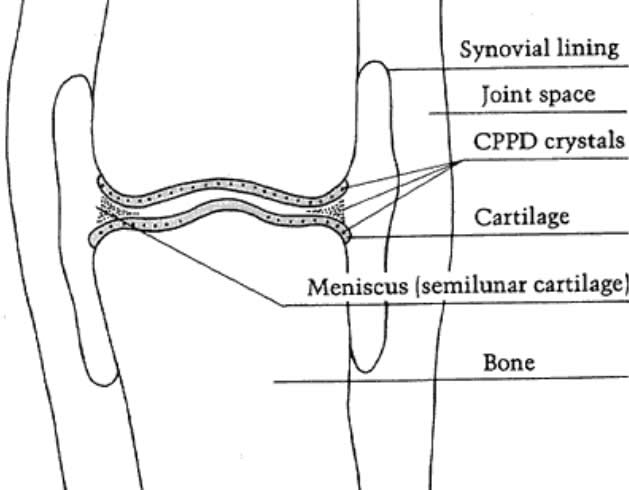Difference between Pseudogout (CPPD disease) and Gout
Pseudogout and gout belong to group of joint disease called arthritis. They can share some same symptoms, particularly such as joint pain that typically comes abruptly. Nevertheless, they are different since each has different cause. What are other differences?
Calcium pyrophosphate dihydrate deposition (CPPD) disease is another alternative name of this arthritis. The term ‘pseudogout’ means that it can be similar to gout.
Symptoms
 Like osteoarthritis (the most common arthritis form), knee joint is the most common site where CPPD disease occurs. Other less common sites include ankles and wrists.
Like osteoarthritis (the most common arthritis form), knee joint is the most common site where CPPD disease occurs. Other less common sites include ankles and wrists.
Typically, it attacks one joint at a time. But sometime, multiple joints can be affected at the same time.
The affected joint is characterized by intense, sudden, and painful – almost similar to a gout attack. The inflammation signs such as swelling, heat, and redness are other common symptoms.
How long does it take to see the improvement of the symptoms? The answer varies. But in general, a pseudogout attack can last for a few days or weeks.
Causes and risk factors
The joint inflammation in both CPPD disease and gout is caused by the deposits of needle-like crystals – but with different composition (the crystal type differs for each disease).
In CPPD disease, the deposits of crystals that cause inflammation have nothing to do with high blood uric acid (the main reason behind a gout attack). Instead, these crystals are usually made from calcium and pyrophosphate.
CPPD is actually a kind of salt. Over time, the accumulation of CPPD can make buildups of crystals. Research showed the presence of calcium pyrophosphate dihydrate crystals in the joint affected by CPPD disease.
* Credit image to orthop.washington.edu
The big question, there is still no exactly answer of why and how calcium pyrophosphate dihydrate crystals can form and cause inflammation in the joint. Because many patients with this arthritis already experience joint damage from other health condition!
Another interesting issue, not all people with these crystals gets the attack. Even most of them never develop CPPD disease.
In other words, the exact cause and how pseudogout occurs are not fully understood yet.
But some risk factors of CPPD disease have been confirmed, these include:
- Age! It is much more common in elderly people aged 60 or older. Furthermore, there is a theory that some changes related to aging (both chemically and physically) may put some people more susceptible to have crystal formation in the joint.
- Joint injury or trauma. According to one theory, an injury that affects the cartilage may allow crystals of calcium to be released into the space in the joint, triggering an inflammatory response.
- The imbalance of minerals may increase the risk, too! For instance, you risk of pseudogout attacks is high if you have too low magnesium or too much iron /calcium in the blood.
- Genetic factor. In some people, the tendency of developing this disease is hereditary. They can get the attack earlier (at younger ages).
It seems that other conditions may also contribute to increase the risk. These include hypothyroid (under-active thyroid), acromegaly (a condition associated with too much growth hormone), parathyroid disease, and some conditions that cause mineral imbalances such as:
- Wilson’s disease, a condition characterized by too much cooper in the body.
- Hemochromatosis, too much iron in the body.
Diagnosis and tests
Since the symptoms of pseudogout are similar to gout, it is often misdiagnosed. Even in a few cases, it can be misdiagnosed as other arthritis forms (such as osteoarthritis and rheumatoid arthritis).
If you have the attack for the first time, the diagnosis of pseudogout can be so tricky. However, some tests are available to help diagnose it:
- Lab test. This can include joint fluid test (to find the presence CPPD crystals) and blood test (to find abnormality associated with mineral imbalances, abnormal function of thyroid and parathyroid glands).
- Imaging test, such as with X-ray test to help show joint damage or reveal the existence of CPPD crystals.
The goal of the treatment
Currently, pseudogout has no cure. But some medications are available to treat it (especially to help ease and improve the symptoms) and prevent it from worsening. In other words, although it is still incurable joint disease but it is treatable and controllable.
It is one of common arthritis forms. It is associated with the formation of crystals in the joint, too. But these crystals are derived from deposits of uric acid that move from the bloodstream to the joint, as noted before.
The attack of gout also can be painful. The affected joint can be stiff, swollen, red, or hotter than the rest of area around the joint. Overall, the symptoms can be similar to those that occur in pseudogout.
To completely understand how gout develops and progresses to the advanced stage see this post!
There is a chance for pseudogout coexists with gout or even other arthritis forms (such as osteoarthritis). But in general, both diseases are rarely found together in the same individual.
The following table is the summary for the differences between pseudogout vs. gout!




